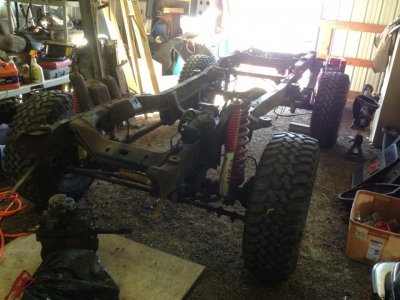Justin or known as RacinNdrummin stop posting on this site, but he did reply on FTE about the above thoughts. I don't get into ******* matches with others, You do it your way and I do it mine. Here is what Justin had to say
"I wanted to address some points that somebody brought up over on the other site in Bronco78idi's thread, and since I cant do it directly, Ill do it here. The poster is a member here, so he can reply here if he wants...
Overthinking cylinder pressures here.
An IDI at the max, will be lucky to see a 2000psi peak cylinder pressure. It has a relatively low burn rate at the beginning of combustion, where most cylinder pressure would be measured. The main factor on that peak number is going to be compression ratio though, and if you aren't running a severely decompressed engine (~16:1), it can equate into some decent cylinder pressures when you start adding energy release into the equation.
When you torque your cylinder head down, you are putting load on a fastener. Your Yield and Tensile strengths just tell you how much load the fastener will hold before failure. Yield on a 7/16 8740 ARP stud is 130ft/lbs of torque, that was where permanent stretch took place. Permanent stretch means the "spring" isn't preloading the attachment any longer. When you leave a little cushion to prevent Yield, lets say 20ft/lbs, you are applying a force to the joint. A 7/16 8740 stud at 110ft/lbs is generating 26,400lbs of clamp load right at the fastener, the farther you move out from that fastener, the number drops substaintially, and is dependent on the rigidity of the material you are fastening.
At 2000psi peak cylinder pressure, the cylinder head has 27,047lbs of force being applied to anywhere within the bore diameter of the gasket (4.150") pushing the head away from the block. The weakest spot is going to be the furthest away from any fastener, on that sealing surface. Our gaskets are about as far away from performance as it gets, so any release of clamp load at significant pressure is going to push that gasket out of position, and if bad enough, right into the water jacket like mine did on the two most unsupported parts of the gasket clamp. Now in these positions, it would be beneficial to have a good gasket that wouldn't push out and fail, but that doesn't mean you wouldn't see a little cooling system pressurization. Regardless, the issue comes down to the stock 6.9 studs not supporting cylinder pressures at 2000'ish psi, the pre-load just isn't there. The only way to get the preload to be safe is better fasteners that will take the load, and at 130ft/lbs of torque, the 625+ stuff is delivering 31,200lbs of force right at the fastener, that's at least 15% more than peak load pushing the head away.
As far as the rest of it goes... Same old story. I don't understand why it is that people are so adamant about scoffing at people that do modifications they want to do because they want to do them. I don't think the Roller Rockers are worth the squeeze, that's been my opinion since the beginning, I just don't see the gains being there, but I think its cool as hell Rob has stepped up to the plate and is going to do it because he wants to, same with the 625+ studs, hell, I even chickened out on that and spent a bunch of money (well more than the 625+ stuff costs) trying another option that has been talked about, and I failed, by my own standards anyway...
Its like running 20psi of boost... When I got into the IDI thing, there was one guy running over 20psi of boost, everybody else said you blow gaskets at 20psi boost, and that you have to keep it under that. Boy was that wrong, now because a few people that are actually willing to try things, we know that that is laughable. We have people making over 750ft/lbs of torque at the wheels on stock 21.5:1 compression, and not blowing gaskets...
Rob has sunk a bunch of money into any IDI because its something he feels will be cool as **** when its done. Since he has started, some parts like the 7/16" studs have been put to the test and are now marginally too weak for his goal. Im sure if he started all over, he would probably do what a few of us wish we would have done and build a 7.3 based engine, but not having that option now, its time to take a chance on some more trick parts. When they work, it will just be another modification in the now long list that people accept as the norm, whether you think its worth the money or not. Sometimes doing something for the sake of doing something is much more important than playing it safe and not."
Thanks Justin for all your support and help on my project!!



